The Fluorescence-Activated Cell Sorting Market is estimated to be valued at USD 3.8 billion in 2025 and is projected to reach USD 7.7 billion by 2035, registering a compound annual growth rate (CAGR) of 7.4% over the forecast period.
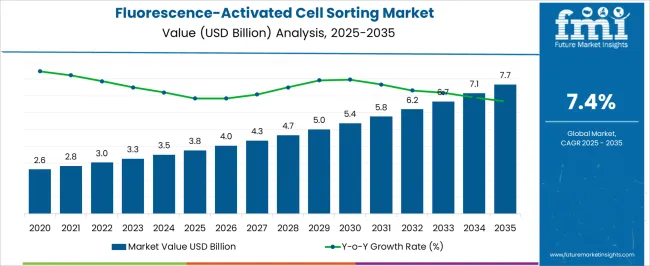
| Metric | Value |
|---|---|
| Fluorescence-Activated Cell Sorting Market Estimated Value in (2025 E) | USD 3.8 billion |
| Fluorescence-Activated Cell Sorting Market Forecast Value in (2035 F) | USD 7.7 billion |
| Forecast CAGR (2025 to 2035) | 7.4% |
The Fluorescence-Activated Cell Sorting market is being expanded steadily by advancements in biomedical research and personalized medicine. The current scenario reflects growing investments in cell-based research, immunotherapy, and cancer diagnostics, where precise cell separation technologies are critical. Increasing prevalence of chronic diseases and the need for targeted therapies are contributing to the adoption of advanced sorting methods that support high-throughput, accurate, and reproducible results.
The market outlook is strengthened by the integration of fluorescence-based cell sorting techniques in multi-omics research, enabling better understanding of disease pathways. The rising collaboration between academic institutions and healthcare companies is further fueling research-based applications.
Improvements in automation and miniaturization are making sorting systems more accessible to laboratories with limited infrastructure, while the ongoing development of novel biomarkers is expanding the scope of cell-based analysis In the future, the growing demand for cell therapy, regenerative medicine, and advanced drug screening is expected to enhance investments in sorting technologies, reinforcing the market’s growth and opening avenues for innovation in cell isolation and molecular characterization.
The fluorescence-activated cell sorting market is segmented by application, end user, and geographic regions. By application, fluorescence-activated cell sorting market is divided into Immunology And Cancer Research, Research Applications Of Fluorescence-Activated Cell Sorting, Virology, Clinical Chemistry, Drug Delivery, Others, and Clinical Applications Of Fluorescence-Activated Cell Sorting.
In terms of end user, fluorescence-activated cell sorting market is classified into Research Institutes, Diagnostic Centers, Hospitals, Clinics, and Laboratories. Regionally, the fluorescence-activated cell sorting industry is classified into North America, Latin America, Western Europe, Eastern Europe, Balkan & Baltic Countries, Russia & Belarus, Central Asia, East Asia, South Asia & Pacific, and the Middle East & Africa.
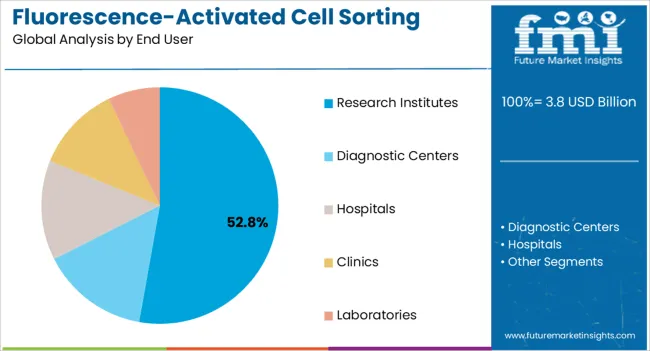
The Immunology and Cancer Research application is expected to hold 44.60% of the Fluorescence-Activated Cell Sorting market share in 2025, emerging as the largest application segment. The dominance of this segment is being attributed to the critical role that cell sorting plays in identifying and isolating immune cell subtypes and tumor cells for advanced research. Increasing interest in immunotherapies and precision oncology has necessitated the use of highly specific sorting techniques that enable the study of rare cell populations and functional assays.
The segment’s growth has been supported by rising funding from public and private organizations for cancer-related research and drug discovery. The adoption of fluorescence-based methods is being accelerated by their compatibility with multi-parameter analysis and real-time detection capabilities.
As research programs aim to better understand immune responses and tumor microenvironments, the demand for cell sorting technologies has been expanded The future outlook is expected to remain robust, as ongoing advancements in biomarker discovery and personalized medicine approaches further encourage the application of cell sorting in immunological and oncological studies.
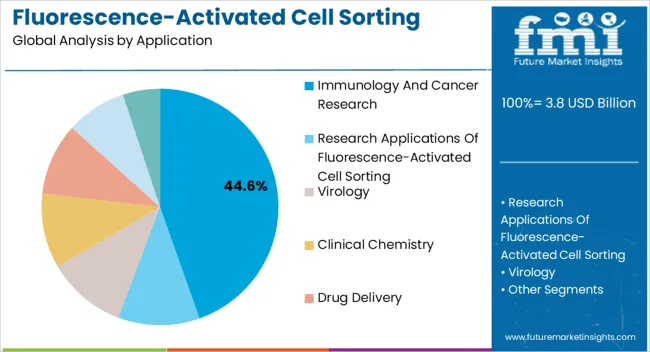
The Research Institutes end user segment is projected to hold 52.80% of the Fluorescence-Activated Cell Sorting market revenue in 2025, making it the leading segment among end users. This leadership is being attributed to the growing need for advanced cell analysis tools in academic and government-funded research facilities. The segment’s expansion has been supported by increasing investments in basic and translational research, where cell sorting systems are essential for studying cell differentiation, signaling pathways, and disease mechanisms.
The adoption of fluorescence-based sorting techniques has been accelerated by their ability to deliver high sensitivity, specificity, and reproducibility, which are critical in cell biology and therapeutic research. In addition, the demand has been fueled by collaborations between research institutes and pharmaceutical companies aimed at enhancing drug discovery pipelines and developing novel therapies.
With the continuous rise in cell-based research projects and global scientific collaborations, the requirement for advanced, automated sorting solutions has been expanded The future growth of this segment is expected to be driven by increasing availability of funding, as well as the integration of sorting platforms into multi-disciplinary research workflows.
Flow cytometry is a procedure that analyzes chemical and physical characteristics of certain particles in a fluid while passing through at least one laser. These cell components are labelled with fluorescence and when laser is passed, these cell components emit light at various wavelengths.
Fluorescence-Activated Cell Sorting is an advanced type of flow cytometry which is used for sorting heterogeneous mixture of living cells based on light scattering properties and fluorescent labelling of the cells.
The suspension of these cells is contained in a rapidly moving, narrow liquid stream, through which vibration caused the liquid stream to break in single droplets. Prior the vibration, liquid stream is passed through one or more laser beams which further allows the fluorescence pattern of individual cell to be identified.
This liquid stream is further broken into droplets depending upon the characteristics chosen from the initial fluorescence analysis. These droplets then pass via an array of electrostatic deflectors. These deflectors divert the droplets in wells or test tubes according to their charge.
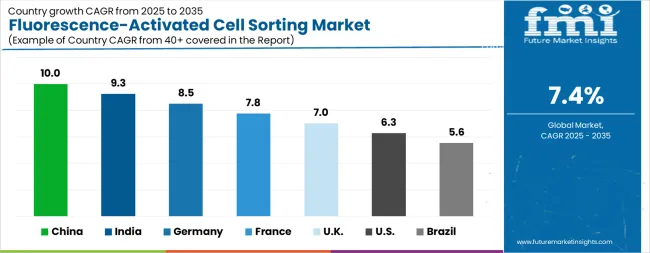
| Country | CAGR |
|---|---|
| China | 10.0% |
| India | 9.3% |
| Germany | 8.5% |
| France | 7.8% |
| UK | 7.0% |
| USA | 6.3% |
| Brazil | 5.6% |
The Fluorescence-Activated Cell Sorting Market is expected to register a CAGR of 7.4% during the forecast period, exhibiting varied country level momentum. China leads with the highest CAGR of 10.0%, followed by India at 9.3%. Developed markets such as Germany, France, and the UK continue to expand steadily, while the USA is likely to grow at consistent rates. Brazil posts the lowest CAGR at 5.6%, yet still underscores a broadly positive trajectory for the global Fluorescence-Activated Cell Sorting Market. In 2024, Germany held a dominant revenue in the Western Europe market and is expected to grow with a CAGR of 8.5%. The USA Fluorescence-Activated Cell Sorting Market is estimated to be valued at USD 1.4 billion in 2025 and is anticipated to reach a valuation of USD 2.6 billion by 2035. Sales are projected to rise at a CAGR of 6.3% over the forecast period between 2025 and 2035. While Japan and South Korea markets are estimated to be valued at USD 195.2 million and USD 99.1 million respectively in 2025.
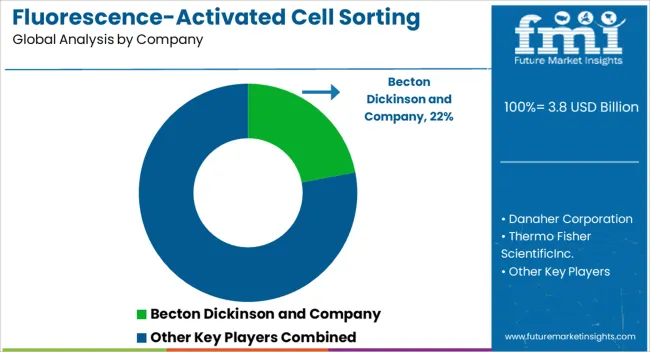
| Item | Value |
|---|---|
| Quantitative Units | USD 3.8 Billion |
| Application | Immunology And Cancer Research, Research Applications Of Fluorescence-Activated Cell Sorting, Virology, Clinical Chemistry, Drug Delivery, Others, and Clinical Applications Of Fluorescence-Activated Cell Sorting |
| End User | Research Institutes, Diagnostic Centers, Hospitals, Clinics, and Laboratories |
| Regions Covered | North America, Europe, Asia-Pacific, Latin America, Middle East & Africa |
| Country Covered | United States, Canada, Germany, France, United Kingdom, China, Japan, India, Brazil, South Africa |
| Key Companies Profiled | Becton Dickinson and Company, Danaher Corporation, Thermo Fisher ScientificInc., Agilent TechnologiesInc., Luminex Corporation, Bio-Rad LaboratoriesInc., Miltenyi Biotec, Sysmex Corporation, StratedigmInc., Apogee Flow Systems Ltd., Sony BiotechnologyInc., Enzo Life Sciences Inc, and Merck KGaA |
The global fluorescence-activated cell sorting market is estimated to be valued at USD 3.8 billion in 2025.
The market size for the fluorescence-activated cell sorting market is projected to reach USD 7.7 billion by 2035.
The fluorescence-activated cell sorting market is expected to grow at a 7.4% CAGR between 2025 and 2035.
The key product types in fluorescence-activated cell sorting market are immunology and cancer research, research applications of fluorescence-activated cell sorting, virology, clinical chemistry, drug delivery, others and clinical applications of fluorescence-activated cell sorting.
In terms of end user, research institutes segment to command 52.8% share in the fluorescence-activated cell sorting market in 2025.






Our Research Products

The "Full Research Suite" delivers actionable market intel, deep dives on markets or technologies, so clients act faster, cut risk, and unlock growth.

The Leaderboard benchmarks and ranks top vendors, classifying them as Established Leaders, Leading Challengers, or Disruptors & Challengers.

Locates where complements amplify value and substitutes erode it, forecasting net impact by horizon

We deliver granular, decision-grade intel: market sizing, 5-year forecasts, pricing, adoption, usage, revenue, and operational KPIs—plus competitor tracking, regulation, and value chains—across 60 countries broadly.

Spot the shifts before they hit your P&L. We track inflection points, adoption curves, pricing moves, and ecosystem plays to show where demand is heading, why it is changing, and what to do next across high-growth markets and disruptive tech

Real-time reads of user behavior. We track shifting priorities, perceptions of today’s and next-gen services, and provider experience, then pace how fast tech moves from trial to adoption, blending buyer, consumer, and channel inputs with social signals (#WhySwitch, #UX).

Partner with our analyst team to build a custom report designed around your business priorities. From analysing market trends to assessing competitors or crafting bespoke datasets, we tailor insights to your needs.
Supplier Intelligence
Discovery & Profiling
Capacity & Footprint
Performance & Risk
Compliance & Governance
Commercial Readiness
Who Supplies Whom
Scorecards & Shortlists
Playbooks & Docs
Category Intelligence
Definition & Scope
Demand & Use Cases
Cost Drivers
Market Structure
Supply Chain Map
Trade & Policy
Operating Norms
Deliverables
Buyer Intelligence
Account Basics
Spend & Scope
Procurement Model
Vendor Requirements
Terms & Policies
Entry Strategy
Pain Points & Triggers
Outputs
Pricing Analysis
Benchmarks
Trends
Should-Cost
Indexation
Landed Cost
Commercial Terms
Deliverables
Brand Analysis
Positioning & Value Prop
Share & Presence
Customer Evidence
Go-to-Market
Digital & Reputation
Compliance & Trust
KPIs & Gaps
Outputs
Full Research Suite comprises of:
Market outlook & trends analysis
Interviews & case studies
Strategic recommendations
Vendor profiles & capabilities analysis
5-year forecasts
8 regions and 60+ country-level data splits
Market segment data splits
12 months of continuous data updates
DELIVERED AS:
PDF EXCEL ONLINE
Cell Sorting Market Share Analysis: Global Industry Analysis and Opportunity Assessment 2025 to 2035
Cellulose Diacetate Film Market Size and Share Forecast Outlook 2025 to 2035
Cellulose Fiber Market Forecast and Outlook 2025 to 2035
Cellulite Treatment Market Size and Share Forecast Outlook 2025 to 2035
Sorting Equipment Market Size and Share Forecast Outlook 2025 to 2035
Cellulose Derivative Market Size and Share Forecast Outlook 2025 to 2035
Cellulose Film Packaging Market Size and Share Forecast Outlook 2025 to 2035
Cell Therapy Systems Market Size and Share Forecast Outlook 2025 to 2035
Cellular IoT Market Size and Share Forecast Outlook 2025 to 2035
Cell Isolation Market Size and Share Forecast Outlook 2025 to 2035
Cellulose Ether and Derivatives Market Size and Share Forecast Outlook 2025 to 2035
Cellular Push-to-talk Market Size and Share Forecast Outlook 2025 to 2035
Cell Culture Waste Aspirator Market Size and Share Forecast Outlook 2025 to 2035
Cell Culture Media Market Size and Share Forecast Outlook 2025 to 2035
Cellulosic Polymers Market Size and Share Forecast Outlook 2025 to 2035
Cellbag Bioreactor Chambers Market Size and Share Forecast Outlook 2025 to 2035
Cell Surface Markers Detection Market Size and Share Forecast Outlook 2025 to 2035
Cellular Modem Market Size and Share Forecast Outlook 2025 to 2035
Cellulite Reduction Treatments Market Size and Share Forecast Outlook 2025 to 2035
Cell Culture Supplements Market Size and Share Forecast Outlook 2025 to 2035

Thank you!
You will receive an email from our Business Development Manager. Please be sure to check your SPAM/JUNK folder too.
Chat With
MaRIA